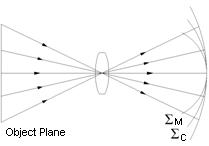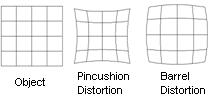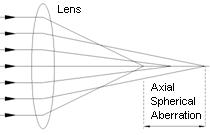
Schematic of astigmatism

Schematic of field curvature

Schematic of distortion

Schematic of spherical aberration
Note: stainless steel optical table or breadboard not provided
Features
Lens Aberration Demonstration
Fourier Optical Processing
Easy Operation
Cost Effective
Introduction
The LEOK-5 Lens Aberration and Fourier Optics Kit is designed to provide students with practical, hands-on experience in understanding optical aberrations and Fourier optics principles. Optical aberrations, such as chromatic aberration, spherical aberration, and astigmatism, are common challenges faced by optical systems. This kit enables students to explore these aberrations and their effects on image quality, enhancing their understanding of real-world optics applications.
The kit also focuses on Fourier optics, particularly the Fourier transformation of light fields in the object plane. Through spatial filtering techniques based on Abbe's theory of image formation, students can deepen their understanding of how optical systems process and filter images.
Through the experiments in this kit, students will explore the following lens aberrations:
1. Spherical Aberration: Investigate the effect of spherical lens surfaces on image formation, where rays passing through the center and the edge of the lens focus at different points.
2. Field Curvature: Observe how the image plane is curved instead of flat when using certain optical systems, leading to distorted images.
3. Astigmatism: Study how rays of light focused on different axes of the optical system result in different focal points, leading to blurry images.
4. Coma: Learn how off-axis light rays cause image points to form comet-like shapes, distorting the image.
5. Distortion: Explore how lenses cause straight lines to appear curved, which affects the shape of objects in the image.
6. Chromatic Aberration: Observe how different wavelengths of light are focused at different points, resulting in color fringing around the image.
Fourier optics explores how Fourier transforms are used in optical systems to process and filter images. The kit includes experiments to demonstrate the following techniques:
1. Low-Pass Filtering: Understand how low-frequency components of an image are passed through while higher frequencies are blocked, smoothing the image.
2. High-Pass Filtering: Explore how high-frequency components are passed through, enhancing the sharpness and detail of an image by removing low-frequency noise.
3. Directional Filtering: Investigate how specific directional frequencies are filtered, allowing for the enhancement of features in a certain direction while reducing others.
The instructional manual contains comprehensive materials including experimental setups, principles, procedures and required parts with photos. Please click to view some sample pages of the instruction manual.
| Description | Specs/Part No. | Qty |
| Optical rail | Aluminum | 1 |
| Laser holder | SZ-42 | 1 |
| Carrier | General | 3 |
| Carrier | X-translation | 2 |
| Carrier | X-Z translation | 2 |
| Lens (DCX) | f = 4.5, 85, 150, 225 mm | 1 each |
| Plano-convex lens (PCX) | f =85 mm | 1 |
| He-Ne laser | LLL-2 (>2.0 mW@632.8 nm) | 1 |
| Tungsten-Bromine lamp | LLC-3 (12 V/30 W, variable) | 1 |
| Transmissive character | 1 | |
| Iris diaphragm | SZ-15 | 1 |
| Adjustable slit | SZ-40 | 1 |
| White screen | SZ-13 | 1 |
| Optical filter | Red and Blue | 1 each |
| Zero order filter | 1 | |
| On/Off axis aperture plate | 1 | |
| Plate holder | SZ-12 | 1 |
| Lens holder | SZ-08 | 4 |
| Adapter piece | SZ-09 | 1 |
| Millimeter ruler | 3 cm | 1 |

Schematic of astigmatism

Schematic of field curvature

Schematic of distortion

Schematic of spherical aberration